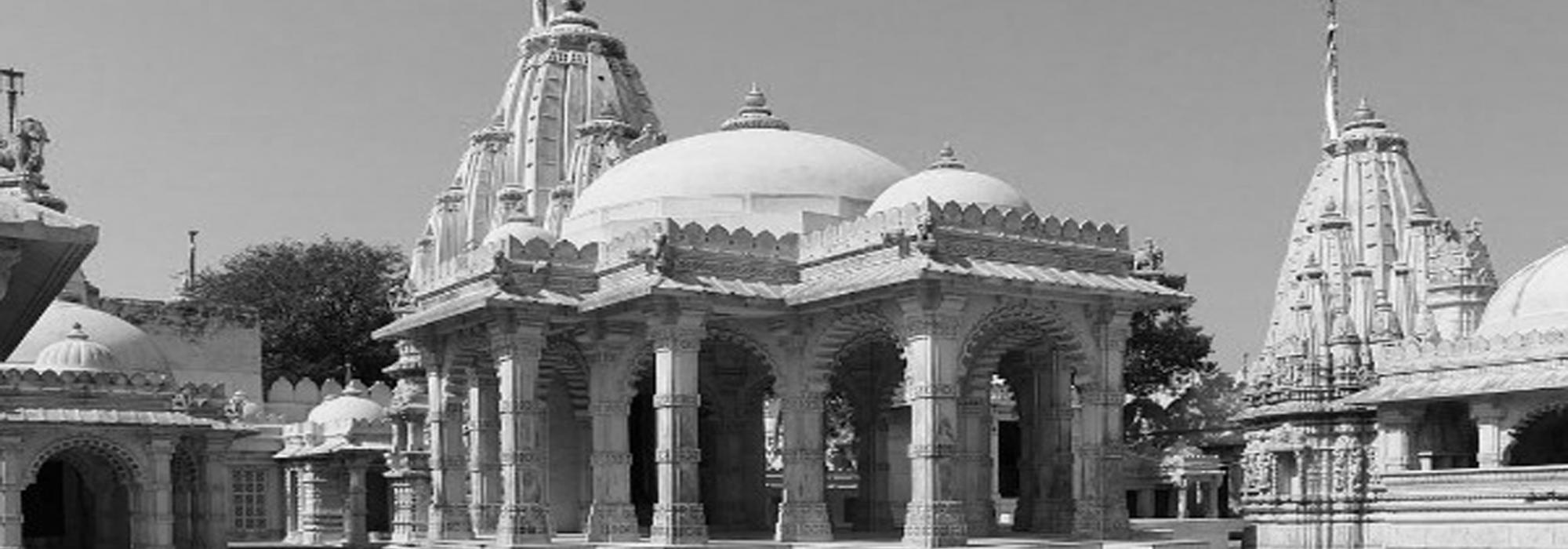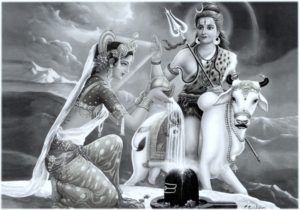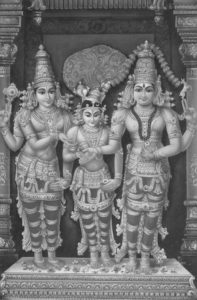Shiva holds the Ḍamaru in one of his hands. This master of laya (dissolution) plays a laya-vadya (percussion instrument). It is said that from the beating of his ḍamaru, the fourteen Māheśvara-sūtras emerged, which form the basis of Sanskrit. There is also a charming legend in the Tamil country that when Shiva beat his drum, Sanskrit appeared from one side and Tamil from the other. The ḍamaru also represents a strange paradox of Shiva – on the outside, he speaks and makes music but within, he is utterly silent. A charming verse from the Maṅkutimmana Kagga (v. 723) of D V Gundappa comes to mind:
ಸ್ವಸ್ಥತೆಯ ಕದಲಿಸದ ಜಗದಾಸ್ಥೆಯೊಂದು ಗುಣ
ಆಸ್ಥೆಯನು ಕುಂದಿಸದ ತಾಟಸ್ಥ್ಯವೊಂದು ।
ನಷ್ಟಲಾಭಂಗಳಲಿ ಲಘುಹಾಸ್ಯನಯವೊಂದು
ಸ್ವಸ್ತಿಗಾವಶ್ಯಕವೊ – ಮಂಕುತಿಮ್ಮ ॥ ೭೨೩
[Interest in world without causing agitation
Tranquility that doesn’t decrease compassion
Light humor and softness in the face of profit and loss
These three virtues are essential for a peaceful life]
Pinakapani and Shulin are names of Shiva, for he holds in his second hand a bow or a trident. His bow, Pinaka, is also known as the praṇava-dhanus, for the omkāra itself is his bow. We know from the Upaniṣads that om represents the avasthā-traya and Shiva is a mere witness to the three states and therefore transcends them. And as for the three-forked śūla, it represents the cessation of three kinds of pain – at the physical level, at the emotional plane, and at the innermost realms. Shiva leads a choiceless life, accepting everything as it comes, and so he is able to destroy all pain.
In his third hand, he is holding a bhikṣā-pātra (begging bowl). He is Ishvara, the master of the universe, the source of all aiśvarya, and he is holding a begging bowl. Such a strange lord! The reason for this is that he is totally detached from wealth and grandeur. He never feels ‘This is mine.’ He has given off all his wealth to the world and begs for the dividends. He is a symbol for prosperity without possessiveness. He is the greatest dānī.
His fourth hand is in cin-mudra. In this mudra, the tips of the thumb and index fingers touch each other while the other three fingers are straightened out. Cin-mudra is a symbol of jñāna. While mudra is a hand gesture of contemplation, hasta is a hand gesture of communication. We know from Bharata’s Nāṭyaśāstra that the cin-mudra corresponds to the hamsāsya hasta. The swan is believed to have the power to separate milk from water and thus the hamsāsya hasta is a symbol of viveka.
Further down, what does he have around his waist? Gajājina (Elephant hide) and Vyaghrājina (Tiger skin). The elephant represents mada, a sense of attachment towards what we possess. The tiger represents krodha, the anger we feel when we don’t obtain what we desire. Shiva, having killed the two animals of attachment and anger is using their skins to cover his private parts. To hide his shame, he wears his victory over these vices. After all, when we defeat an Evil, that becomes our adornment.
He rubs the smaṣāna-bhasma (ashes from the cemetery) all over his body, for that is a symbol of what finally remains. No further reduction is possible. These ashes represent the ultimate wisdom that remains after ignorance has been burnt and exhausted.
Shiva rides on Nandi. His vehicle is the bull, which is not as fast as a horse but is steadier by far. The bull is a symbol for dharma; what else can be the vehicle of wisdom than dharma? If jñāna-svarūpī Shiva has to choose a mode of transport, will it not be dharma-svarūpī Nandi? Shiva might have transcended dharma and adharma but for the sake of loka-saṅgraha, he still abides by dharma.
On the one hand, Shiva is sthāṇu but on the other, he is the naṭarāja. He is still and yet he dances. He is himself and yet he acts. This is a paradox. How can one sit still and yet dance? Once the citta-vṛtti of a person is peaceful, there’s no problem even if he jumps about, dances, or acts. His every action merges into his person. Apart from being a mahā-naṭa, he is also a mahā-senāni. How can a dancer be a warrior? When there is a war, he has to face a pratyakṣa-vairi, the visible enemy, whom he fights without holding back. However, during times of peace, he has to face the apratyakṣa-vairi, an invisible enemy that is within. Having conquered that inner enemy, he dances. He sublimates his bhāva (personal emotions) to the level of rasa (art experience). Instead of being disturbed by emotional upheavals, he looks at them as part of a grand drama and is therefore able to enjoy it.
Shiva lives atop the Himalayas. Normally, when we scale a mountain or go atop a hill, after a while we wish to climb down. We can’t stay there for too long; even the oxygen supply becomes scarce. But Shiva can stay at that high level forever. He is always at peace. He can be his best at all times.
Now, what about his family and friends? His wife has taken half his body; he is ardhanārīśvara. His friend Vishnu has
taken half his body; he is harihara. Shiva, therefore, has no body at all! He loves his wife but not at the cost of losing his friendships. He loves his friends but not at the cost of creating marital discord. And what can he offer to his wife or friends? Nothing but his body. And that’s what he has done. In spite of this, he is not śūnya, he is pūrṇa. In nothingness he finds infinity.
Shiva’s wife is Parvati. In her previous birth, she was Sati, and was married to Shiva. When she was adamant and wanted to return to her father’s place for the yajña, Shiva didn’t accompany her. And when she was sacrificed in the dakṣa-yajña, Shiva went mad with rage. He was shattered at her death and avenged it. He lamented for her and waited until she took another birth. When Parvati tried to win over Shiva through her physical beauty, Shiva didn’t respond to that arrogant stance. He even went to the extent of burning Desire. But when Parvati performed rigorous tapas, he knelt before her and told her that she had completely won him over. While Shiva didn’t tolerate his wife’s adamancy or arrogance, he immediately fell for her goodness of heart. He is inseparable from his consort. Adi Shankara says that without Shakti, Shiva cannot even move an inch!
Shiva’s son is Kumara, also known as Skanda or Subrahmanya. Unlike many parents, Shiva was willing to learn from his son; not with an air of condescension but with a genuine openness to know. And his second son is Ganesha, also known as a Ganapati or Vighnesvara. He is offered the agra-pūjā, the first worship, and became even more famous than his father. Shiva feels neither melancholy nor excessive joy. He accepts the greatness of his wife and children.
Ganesha’s vehicle is the rat, the staple food of the snakes, which are adorning Shiva’s body. Kumara’s vehicle is the peacock, which typically feasts on snakes. The bull, which is Shiva’s vehicle, forms the food for the tiger, which is Parvati’s vehicle. In spite of all this, there is harmony in his family. It is aligned to nature. Even there, we find a grand food chain but that doesn’t lead to extinction of a certain species (except in specific cases).
One of the important lessons from Shiva, the Pashupati (lord of all creatures), is that if we want to ensure ecological balance, first we have to limit our own consumption, and this in turn comes from controlling desires. In the benedictory verse of Mālavikāgnimitram, Kalidasa captures in verse the seemingly conflicting nature of Shiva:
एकैश्वर्ये स्थितोऽपि प्रणतबहुफले यः स्वयं कृत्तिवासाः
कान्तासंमिश्रदेहोऽप्यविषयमनसां यः परस्ताद्यतीनाम् ।
अष्टाभिर्यस्य कृत्स्नं जगदपि तनुभिर्बिभ्रतो नाभिमानः
सन्मार्गालोकनाय व्यपनयतु स वस्तामसीं वृत्तिमीशः ॥
Shiva can bestow any amount of wealth to one who seeks, but he himself is dressed in animal hide!
He shares half his body with his beloved wife, yet he is disinterested in worldly matters and is the greatest of saints!
He protects the world with his eight forces, yet he hasn’t an iota of pride!
Let this lord of the world lead my mind towards the right path of salvation, destroying the darkness within!
(In the invocatory verse of Abhijñāna-śākuntalam, Kalidasa lists the eight forms of Shiva.)
What is often called as heaven, earth, and hell are all within us. What is heaven but our joy? What is earth but our patience and forbearance? What is hell but our pains and sufferings? The Kumārasambhavam of Kalidasa beautifully captures the various shades of Shiva. When Kāma (personification of desires) comes at a wrong time and at the wrong place, he burns him. But he rejuvenates Kāma at the right place and at the right time. Ultimately, he is a person who accepts reality and sublimates his desires. He is not against the basic instincts but goes beyond it.
Our ancients identified the four basic instincts of humans – hunger, thirst, fear, and desire for sex. Shiva too has these instincts but he has gone beyond them. And even when he makes allowance for fulfilling these basic instincts, he never violates ṛta (cosmic order), dharma (sustainability principle), and satya (truth). It is meaningless to shun these desires as evil because the entire animal kingdom is based on these fundamental instincts. Without desire, there will be no creation, and without creation, the universe will come to a standstill. Thus the Upanishadic vision is to allow for desires within the framework of ṛta-dharma-satya.
Shiva is not just a jñāna-svarūpī but also the vaidyanātha; he cures the afflictions of mind and body. He is the ultimate refuge and the ideal person.
To be continued.
This serialized article has been translated by Hari Ravikumar from the author’s Kannada lecture held at the Gokhale Institute of Public Affairs, Bangalore in 2009. Thanks to Shashi Kiran B N for his careful review and astute feedback.





































